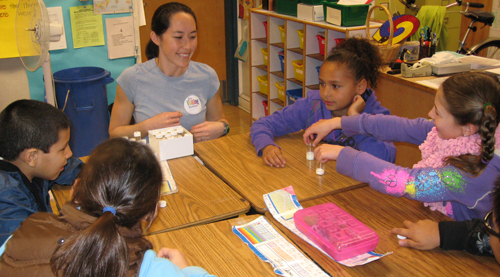Kim Sogi: A Role Model for Science
February 2012
Chemistry PhD candidate Kim Sogi may not look like your typical scientist. When she goes into classrooms with her team of volunteers teachers often comment how wonderful it is for their students to see female scientists in their classrooms
 As one of the 24% of women working in a STEM – Science, Technology, Engineering, and Math – profession, Chemistry PhD candidate Kim Sogi may not look like your typical scientist. So, when she goes into classrooms with her team of volunteers, a good number of whom are also women, teachers often comment how wonderful it is for their students to see female scientist role models in their classrooms. Though she says she’s never experienced any prejudices or felt slighted by other scientists as a woman, Kim proposes that the biggest challenge now is to get more young kids, male and female, to be excited about science and pursue it as a career.
As one of the 24% of women working in a STEM – Science, Technology, Engineering, and Math – profession, Chemistry PhD candidate Kim Sogi may not look like your typical scientist. So, when she goes into classrooms with her team of volunteers, a good number of whom are also women, teachers often comment how wonderful it is for their students to see female scientist role models in their classrooms. Though she says she’s never experienced any prejudices or felt slighted by other scientists as a woman, Kim proposes that the biggest challenge now is to get more young kids, male and female, to be excited about science and pursue it as a career.
For 5 years, Kim and her co-presenters in the Bertozzi lab have been introducing students to the scientific method in her lessons “Properties of Matter that Matter” for 3rd grade and “How to Think Like a Scientist” for 5th grade. Over that time, she’s had a chance to see the wide range of diversity and disparities in East Bay schools. Her most memorable experience teaching was in a bilingual third grade classroom. One of the students didn’t understand English very well and wasn’t able to follow the lesson. The girl sitting next to him translated her understanding of the lesson into Spanish without any prompting from the teacher or presenters. It was so exciting to see the first student’s face light up when he understood what was going on.
Each classroom visit presents unexpected surprises that the Bertozzi group uses as teaching moments. Sometimes, volunteers will forget to wash the cups used for testing the pH of various liquids in the “How to Think Like a Scientist” lesson and the control sample for a base will come out acidic. Oh no! Don’t worry though, it’s a great chance to remind kids that you should always wash your materials after every experiment and that good science requires reproducing results and accounting for all the variables.
Another demo for a fifth grade class involves adding a small amount of elemental potassium to water the reaction which usually catches on fire briefly. At one class visit, this sparked a few students to only ask questions about how to make various explosives, starting with firecrackers and matches. “We drew the line at answering questions about how to make touch explosives and napalm,” the volunteers recall with a laugh.
But, it’s not just about what kids are learning from the Bertozzi group but what they learn from the kids. “We have received thank you letters from some of the classes we taught. Reading the thank you notes gives us insight into what students understood and how we can improve our lesson. Explaining my research to third and fifth graders in words and concepts they understand has helped me when explaining my research to non-scientists.” Kim later goes on to say that, “it’s easy to get your head buried in research. Going into classrooms and seeing the excitement of the kids really puts a new perspective on my work, and that’s really exciting.”
Kimberly Sogi is a doctoral candidate in Dr. Carolyn Bertozzi’s lab which studies the molecules involved in cell to cell communication and cell surface interactions that contribute to human health and disease.